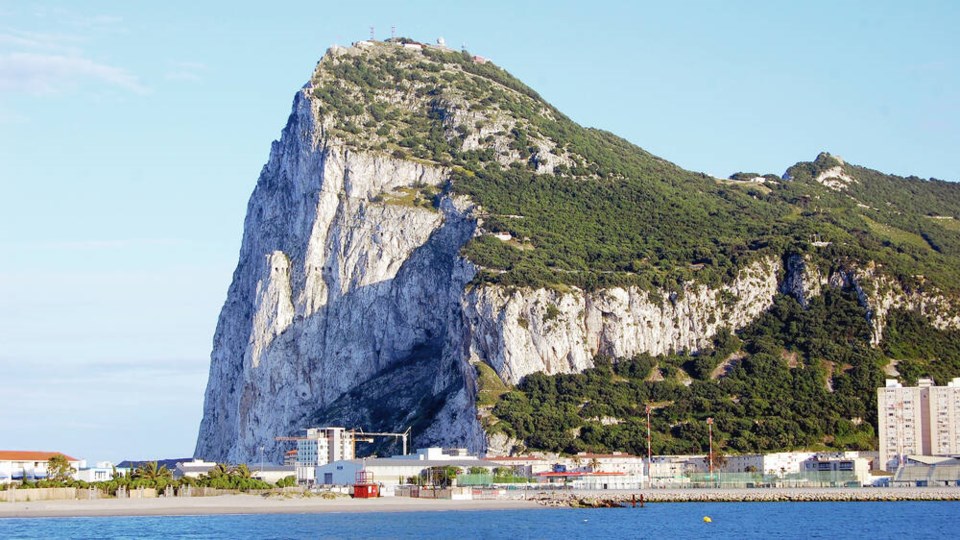When in southern Spain, I can’t resist popping into the British colony of Gibraltar. Gibraltar is hardly signposted in Spain, as if Spain wishes the British colony didn’t exist. (Drivers follow highway signs to La Lînea, the last Spanish town before the border.) But when you see that famous “Rock of Prudential” standing boldly above the sea, you know it’s here to stay.
The 30,000 people living along a four-kilometre lip of land under the famous and strategic rock are happily English. And quirky Gibraltar is determinedly not Spanish. But while over 90 per cent of its citizens chose to stay with Britain in a 2002 referendum, almost 96 per cent chose to stay with the European Union during the 2016 Brexit referendum, showing the complicated position the colony faces going forward.
Along with being “not Spanish,” the colony is part English and part … not. Gibraltarians have the big three-pronged British electrical plugs, their own currency (it’s the pound sterling — but, like the Scots, they have their own version), and their own Web domain (.gi). Gibraltar’s Anglican Church is proudly “headquarters of the Anglican Church in Europe” (not very centrally located for the business of administering that vast parish).
The people have that typical British correctness — I got lectured by the woman at the tourist board for not giving them advance notice of my visit. They recently tried to change the name of what for many centuries has been known as the “Moorish Castle” to the “Medieval Castle” (but it is Moorish, so it didn’t stick).
Gibraltar’s economy, once dominated by the military, is now based mostly on tourism. And that includes quickie weddings — that are nonetheless “legally British.” Sean Connery got married here.
And, of course Beatle fans remember from the Ballad of John and Yoko that Mr. and Mrs. Lennon, too, “got married in Gibraltar near Spain.”
While the British military presence is now dwarfed by the British sun-seeker presence, the colony is encrusted with military souvenirs — stout ramparts, war memorials, and 50 km of defence-related tunnels drilled into its rock. As you drive the military roads that switchback to the summit of the rock, you notice big rusted iron rings spiked into the pavement every 20 yards — designed to enable soldiers to hoist up the giant cannons that once helped the Brits seal off the Mediterranean.
The town of Gibraltar is pretty humble. Spaniards come for duty-free sugar, tobacco and booze. For sightseers, the attraction here is the rock itself, with its viewpoint on the summit, gregarious “apes” (actually a gang of about 200 tailless monkeys — whose presence here supposedly assured the continued British control of the colony), and siege galleries — tunnels drilled for military purposes over the centuries. Several hundred yards of tunnel are open to visitors, allowing you to hike across the face of the rock and actually peer out of the cannon holes back at Spain. You can ride a cable car to the rock’s summit, or get there on a taxi tour. Gibraltar’s taxi drivers are trained to give a fun circuit around the rock with several stops, grand views, and — the highlight for many — some fun with those precocious monkeys. The lift and the 90-minute taxi tour each cost about $40.
Old England seems to permeate the island. As we drove high above the port, my taxi driver pointed down to a tiny breakwater and said, “That’s where they pickled Admiral Nelson after the Battle of Trafalgar.” (Though Nelson won that battle, he didn’t survive it. According to legend, his body was preserved in a barrel of spirits for the trip back to London.)
The Gibraltar business sense is quirky. The hotels are twice as expensive as those across the border in Spain, but not as comfortable. For quite a while now, I’ve been quick to tell travellers that English food no longer deserves its bad reputation. But after several Gibraltar visits I’m now quick to add that the cliché is still accurate in Gibraltar. And the businesses here pad their bottom line by gouging anyone who comes in and spends euros. Businesses are keen to advertise that they accept euros; it’s only later that most tourists realize this “convenience” comes with about a 20 per cent loss in the exchange rate.
Nevertheless, tourism is booming. Midday, the pedestrianized main street (which locals call “Main Street”) is a virtual human traffic jam. And more planes are landing in the colony than ever before. While that only comes to a handful of planes a day, it’s now more important than ever that when you walk across the military airstrip that marks the border between Spain and this quirky remnant of the British Empire — you look left, right … and up.
Rick Steves (ricksteves.com) writes European guidebooks, hosts travel shows on public TV and radio, and organizes European tours. You can email Rick at [email protected] and follow his blog on Facebook.



